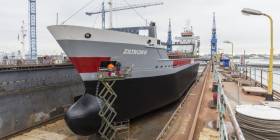Displaying items by tag: Floating DryDocks
Heightened Activity in Cork Dockyard Evokes Memories of Floating Dry-Dock
#FloatingDock - Dublin based Corrib Shipping Group’s management of a newly acquired cargoship that went into a floating dry-dock in the Netherlands last month brings memories of a similar former structure in Cork Dockyard, writes Jehan Ashmore.
The cargoship Ziltborg is the fifth in the fleet of the Irish group but is owned by Wagenborg. They are based in Delfzij where in the previous report a photo features only a close up of the ship's bow while in the Dutch floating dry-dock.
Another connection with Ireland was Dutch shipping magnet Cornelius Verolme who in 1957 was invited by the fledging State owned Irish Shipping Ltd (ISL) that set up a repair dockyard at the Rushbrooke dockyard (origins dating from 1853) to purchase and assist in the development of Irish shipbuilding industry. This led to the establishment of the Verolme Cork Dockyard.
In 1984 however V.C.D. closed and also that same year saw the collapse of ISL. Since then there have been interim owners of the dockyard and in 1995 Cork Dockyard was in the hands of Burke Shipping. The Cork family owned business still controls the dockyard and in late 2015 the shipping and logistics agency was rebranded as Doyle Shipping Group (DSG).
As reported on Afloat, Cork Dockyard is where currently large scale marine engineering activity is underway as three giant Liebherr cranes towering 85m high having been erected on site are bound for San Juan, Puerto Rico. The ship-to-shore container cranes had been manufactured at Liebherr's plant near Killarney and from there taken to the port of Fenit, Co. Kerry and shipped by sea to Cork Dockyard for assembly. Such activity evokes memories of the yard’s former floating dry-dock, again a unconventional structure that was unique in Irish waters.
The floating dry-dock was higher than the dockyard's quay and was berthed east of where the heavy-lift ship Albatross is to be loaded with the cranes. This will involve rails at the quayside to transfer the ship-to-shore container cranes before shifting berths to Ringaskiddy and eventually departure from Cork Harbour this week.
Likewise of the much higher cranes to be exported by the ship across the Atlantic to the Carribean, the floating dry-dock was too equipped with cranes. They were perched atop at the entrance of the structure.
Cork Dockyard continues to repair and overhaul ships using a conventional land-based graving dry-dock. The facility is now unique as the only drydock left in the State following the recent closure in Dublin last month. By coincidence, the graving dry-dock was opened in 1957, the same year of Verolme's notable entry into Irish maritime industry that saw 33 ships built under his stewardship as they slipped down into the River Lee. The yard at its peak employed more than 1,500, however the last vessel built in this State at V.C.D was Naval Service flagship, L.E. Eithne in 1984.
It was more than a decade ago that a visit was made to Cork Dockyard especially to observe the Siren on board the floating dry-dock which remained under new owners. Siren, a former Trinity House Lighthouse tender had sailed previously onto the silver screen in Neil Jordan’s ‘Micheal Collins’. In the film she featured as an Irish Sea mail-boat taking senior Irish delegation officials to the pivotal ‘Treaty’ negotiation talks of 1921 held in London with the British Government.
Priot to the film-making, Siren had been based during the early to mid-1990’s in both Dun Laoghaire Harbour, along the East-Pier followed by those in Dublin Port at Sir John Rogersons Quay. Siren had until then served as a survey ship in Irish waters and among ports spent some time based in Waterford City.
The presence of the aforementioned heavy-lift ship, Albatross in an Irish port is rare. The former bulk-carrier, Tordis Knutsen which was converted to carry such large loads has at Rushbrooke been accompanied within the port by another newly acquired vessel but directly Irish owned tug DSG Titan. The green-hulled tug that at first glance strongly resembles to a pair of Dublin Port tugs, is seen in the related report photograph alongside the Albatross.
The tug’s prefix, DSG as previously referred is that of Doyle Shipping Group. They chartered in the Albatross on behalf of Liebherr to transport the ship-to shore container cranes across the Atlantic Ocean.





























































